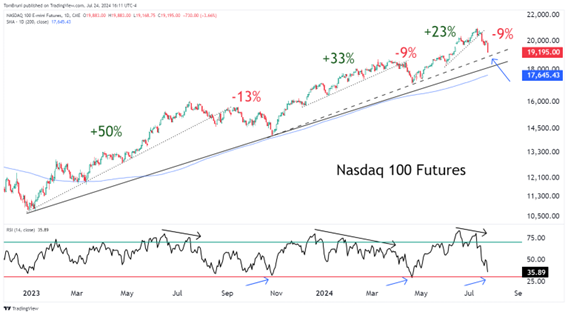Tech Stocks: Sharp Decline? Yes. Out Of The Ordinary? No.
Image Source: Unsplash
“Stocks take the escalator up and the elevator down” is a common phrase you’ll be hearing more of as volatility picks up and stocks experience their second major decline of the year. But from a technical perspective, this pullback has been sharp, but otherwise pretty ordinary, writes Tom Bruni, head of market research at The Daily Rip by Stocktwits.
The S&P 500 snapped its 356-day streak of low volatility by falling more than 2% Wednesday, while the Nasdaq 100 recorded its worst day since the depth of the 2022 correction by falling 3.59%.
But the chart below shows a couple of things. The first is the various trendlines that have acted as a guide for the market’s trend since it bottomed in late 2022. The dotted trendlines show accelerated trendlines that were too steep to be sustainable, while the solid trendline shows the longer-term trend that remains intact.

Additionally, it's worth noting that each correction we’ve had so far started with the combination of a bearish momentum divergence and prices breaking their accelerated trendline. This time was no different.
So, what are technical analysts watching with this roadmap as their guide? Well, they can see that prices are approaching two potential trendlines of support, and the momentum indicator (RSI) is nearing “oversold” levels where it has previously bottomed.
Now, it’s important to remember these are “potential” levels where buyers may step back in. There are no guarantees in markets. But the point is that multiple trendlines, prior price highs, and a 200-day moving average in the range of 3%- 8% below current levels could offer some support.
As for what caused this? Tech earnings were the main culprit. But another factor was that the US remains behind its international peers in the rate-cut cycle.
The Bank of Canada cut its rates for the second consecutive meeting this week, along with China and the European Central Bank (ECB) over the last week. Notably, Canada’s central bank’s tone was decisively dovish, with members flagging downside risks to the economy.
That helped raise the market’s fears that the Fed is once again behind the curve and risking a recession by reacting too slowly.
About the Author
Tom Bruni is the head of market research at Stocktwits, where he publishes the brand’s flagship market recap newsletter, The Daily Rip, for one million subscribers and oversees the platform’s growing publishing efforts.
Mr. Bruni has been at the intersection of finance and media for the last decade, regularly featured in the Wall Street Journal, Bloomberg, Reuters, Barron’s, and more. He holds both CPA and CMT licenses and graduated with an accounting degree from Molloy University in 2016.
More By This Author:
Teradyne: What Earnings And The Market Reaction Say About The Semiconductor Sector
What I'm Watching In This "And Then There Were None" Market
EEM: An Emerging Markets ETF To Consider As Wild Market Rotation Plays Out
Disclosure: © 2024 MoneyShow.com, LLC. All Rights Reserved. Before using this site please read our complete Terms of Service, ...
more




Over? I doubt it.